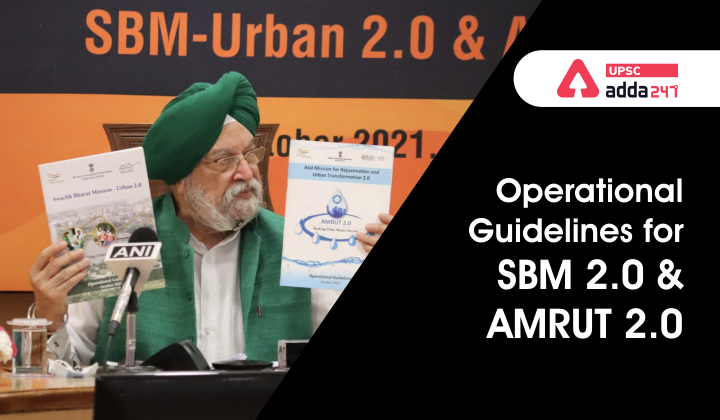Table of Contents
Relevance
- GS 2: Government policies and interventions for development in various sectors and issues arising out of their design and implementation.
Context
- Recently, Ministry of Housing & Urban Affairs has launched the SBM 2.0, and AMRUT 2.0 guidelines.
Swachh Bharat Mission (Urban) guidelines
Key points
- SBM 2.0 envisions to make
- To make all cities ‘Garbage Free’ and ensure grey and black water (used water) management in all cities other than those covered under AMRUT,
- making all urban local bodies ODF+ and those with a population of less than 1 lakh as ODF++,
- make the cities water+ thereby ensuring that no untreated used water is discharged in open to pollute water bodies, thus achieving the vision of safe sanitation in urban areas.
- The Mission will also focus on
- source segregation of solid waste,
- utilizing the principles of 3Rs (reduce, reuse, recycle),
- scientific processing of all types of municipal solid waste and remediation of legacy dumpsites for effective solid waste management.
SBM Achievement
- SBM has achieved sustainable sanitation in over 3,300 cities and over 950 cities have been certified ODF+ and ODF++ respectively.
- Also, 9 cities have been certified Water+, which entails treatment of wastewater and its optimum reuse.
- The thrust on scientific waste management is evident with waste processing in India going up by over four times from 18% in 2014 to 70% today.
- This has been aided through 100% door-to-door waste collection in 97% wards and source segregation of waste being practised by citizens in letter and spirit across 85% wards.
- The active participation of 20 crore citizens (comprising over 50% of India’s urban population) in the program has successfully transformed the Mission into a people’s movement, a true Jan Andolan.
AMRUT 2.0
Key points
- Under AMRUT 2.0, cities will submit City Water Balance Plans (CWBPs) online on a robust Mission portal of MoHUA.
- CWBPs will give the status of water availability, water demand and supply in the city culminating in gaps in services.
- With target of filling theses gaps projects will be formulated in from of City Water Action Plan.
- These plans will be aggregated at State level in form of State Water Action Plan (SWAP).
- Mission mandates implementation of 10% worth of funds allocated to million plus cities in PPP mode.
Swachh Survekshan Grameen 2021
Key components
- Pey Jal Survekshan, Information, Education & Communication (IEC), Technology sub-Mission and Capacity Building are also key components of Mission.
- Pey Jal Survekshan will assess quality and quantity of water supplied to the citizens and will instill healthy competition among cities to provide better water related services to the citizens.
- IEC campaign targets to convert water conservation into a Jan Aandolan. Start-ups in water sector will also be encouraged through Technology sub-Mission.
- Capacity building program shall impart training to elected representatives, Municipal functionaries and larger audience comprising contractors, managers, plumbers, plant operators, workmen, consultants, students, women, and citizens.
Funding
- Project funds will be released in three instalments of 20:40:40.
- Implementation of reforms on Property Tax and user charges is mandatory to get uninterrupted funding from third year onwards.
- Cities will also submit City Aquifer Management Plans with focus on maintaining positive ground water balance in aquifers.
- Mission management will be paperless and on a complete online platform.
- Under the gig economy model, Mission will co-opt women and youth for concurrent feedbacks about its progress.
SACRED Portal for Senior Citizens
Reform agenda
- Reducing non-revenue water to below 20%;
- recycle of treated used water to meet at least 20% of total city water demand and 40% for industrial water demand at State level;
- 24×7 water supply with ‘Drink from tap’ facility; rejuvenation of water bodies;
- GIS based master plans of the cities & efficient town planning;
- credit rating of cities and raising funds through issuance of municipal bonds.




 TSPSC Group 1 Question Paper 2024, Downl...
TSPSC Group 1 Question Paper 2024, Downl...
 TSPSC Group 1 Answer key 2024 Out, Downl...
TSPSC Group 1 Answer key 2024 Out, Downl...
 UPSC Prelims 2024 Question Paper, Downlo...
UPSC Prelims 2024 Question Paper, Downlo...





